并购的财务风险研究外文翻译
- 格式:doc
- 大小:65.50 KB
- 文档页数:10
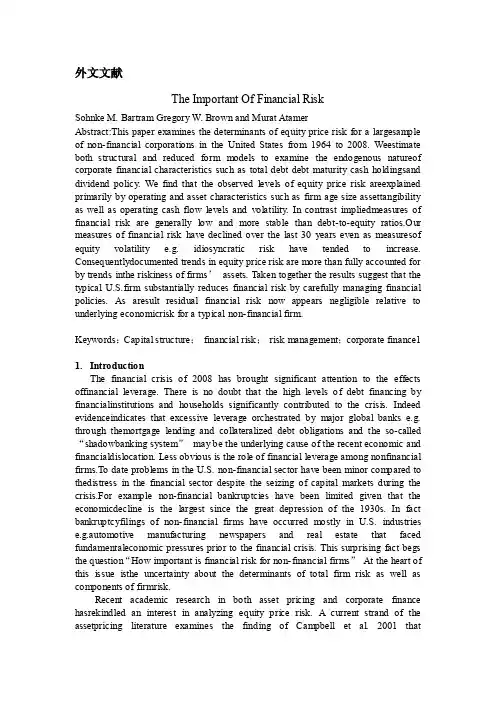
外文文献The Important Of Financial RiskSohnke M. Bartram Gregory W. Brown and Murat AtamerAbstract:This paper examines the determinants of equity price risk for a largesample of non-financial corporations in the United States from 1964 to 2008. Weestimate both structural and reduced form models to examine the endogenous natureof corporate financial characteristics such as total debt debt maturity cash holdingsand dividend policy. We find that the observed levels of equity price risk areexplained primarily by operating and asset characteristics such as firm age size assettangibility as well as operating cash flow levels and volatility. In contrast impliedmeasures of financial risk are generally low and more stable than debt-to-equity ratios.Our measures of financial risk have declined over the last 30 years even as measuresof equity volatility e.g. idiosyncratic risk have tended to increase. Consequentlydocumented trends in equity price risk are more than fully accounted for by trends inthe riskiness of firms’assets. Taken together the results suggest that the typical U.S.firm substantially reduces financial risk by carefully managing financial policies. As aresult residual financial risk now appears negligible relative to underlying economicrisk for a typical non-financial firm.Keywords:Capital structure;financial risk;risk management;corporate finance1 1.IntroductionThe financial crisis of 2008 has brought significant attention to the effects offinancial leverage. There is no doubt that the high levels o f debt financing by financialinstitutions and households significantly contributed to the crisis. Indeed evidenceindicates that excessive leverage orchestrated by major global banks e.g. through themortgage lending and collateralized debt obligations and the so-called “shadowbanking system”may be the underlying cause of the recent economic and financialdislocation. Less obvious is the role of financial leverage among nonfinancial firms.To date problems in the U.S. non-financial sector have been minor compared to thedistress in the financial sector despite the seizing of capital markets during the crisis.For example non-financial bankruptcies have been limited given that the economicdecline is the largest since the great depression of the 1930s. In fact bankruptcyfilings of non-financial firms have occurred mostly in U.S. industries e.g.automotive manufacturing newspapers and real estate that faced fundamentaleconomic pressures prior to the financial crisis. This surprising fact begs the question“How important is financial risk for non-financial firms”At the heart of this issue isthe uncertainty about the determinants of total firm risk as well as components of firmrisk.Recent academic research in both asset pricing and corporate finance hasrekindled an interest in analyzing equity price risk. A current strand of the assetpricing literature examines the finding of Campbell et al. 2001 thatfirm-specificidiosyncratic risk has tended to increase over the last 40 years. Other work suggeststhat idiosyncratic risk may be a priced risk factor see Goyal and Santa-Clara 2003among others. Also related to these studies is work by Pástor and V eronesi 2003showing how investor uncertainty about firm profitability is an important determinantof idiosyncratic risk and firm value. Other research has examined the role of equityvolatility in bond pricing e.g. Dichev 1998 Campbell Hilscher and Szilagyi2008.However much of the empirical work examining equity price risk takes the riskof assets as given or tries to explain the trend in idiosyncratic risk. In contrast thispaper takes a different tack in the investigation of equity price risk. First we seek tounderstand the determinants of equity price risk at the firm level by considering totalrisk as the product of risks inherent in the firms operations i.e. economic or businessrisks and risks associated with financing the firms operations i.e. financial risks.Second we attempt to assess the relative importance of economic and financial risksand the implications for financial policy.Early research by Modigliani and Miller 1958 suggests that financial policymay be largely irrelevant for firm value because investors can replicate manyfinancial decisions by the firm at a low cost i.e. via homemade leverage andwell-functioning capital markets should be able to distinguish between financial andeconomic distress. Nonetheless financial policies such as adding debt to the capitalstructure can magnify the risk of equity. In contrast recent research on corporate riskmanagement suggests that firms may also be able to reduce risks and increase valuewith financial policies such as hedging with financial derivatives. However thisresearch is often motivated by substantial deadweight costs associated with financialdistress or other market imperfections associated with financial leverage. Empiricalresearch provides conflicting accounts of how costly financial distress can be for atypical publicly traded firm.We attempt to directly address the roles of economic and financial risk byexamining determinants of total firm risk. In our analysis we utilize a large sample ofnon-financial firms in the United States.Our goal of identifying the most importantdeterminants of equity price risk volatility relies on viewing financial policy astransforming asset volatility into equity volatility via financial leverage. Thusthroughout the paper we consider financial leverage as the wedge between assetvolatility and equity volatility. For example in a static setting debt provides financialleverage that magnifies operating cash flow volatility. Because financial policy isdetermined by owners and managers we are careful to examine the effects of firms’asset and operating characteristics on financial policy. Specifically we examine avariety of characteristics suggested by previous research and as clearly as possibledistinguish between those associated of the company(i.e. factors determining economic risk) and those associated with financing the firm(i.e. factors determining financial risk).We then allow economic risk to be a determinant of financial policy in the structural framework of Leland and Toft(1996),or alternatively, in a reduced form model of financial leverage.An advantage of the structural model approach is that we are able to account for both the possibility of financial and operating implciations ofsome factors(e.g .dividends),as well as the endogenous nature of the bankruptcy decision and financial policy in general.Our proxy for firm risk is the volantility if common stock returns derived from calculating the standard deviation of daliy equity returns.Our proxies for econmic risk are designed to capture the essential charactersitics of the firm’s operations and assets that determine the cash flow generating process for the firm.For example,firm size and age provide measures of line of –business maturity; tangible assets(plant,property,and equipment)serve as a proxy for the ‘hardness’of a firm’s assets;capital expenditures measure captial intensity as well as growth potential.Operating profitability and operating profit volatility serve as measures of the timeliness and riskiness of cash flows.To understand how financial factors affect firm risk,we examine total debt,debt maturity,dividend payouts,and holdings of cash and short-term investments.The primary resuit or our analysis is surpriing:factors determining economic risk for a typical company exlain the vast majority of the varation in equity volatility.Correspondingly,measures of implied financial leverage are much lower than observed debt ratios. Specifically, in our sample covering 1964-2008 average actual net financial (market) leverage is 1.50 compared to our estimates of between 1.03 and 1.11 (depending on model specification and estimation technique).This suggests that firms may undertake other financial policise to manage financial risk and thus lower effective leverage to nearly negligible levels.These policies might include dynamically adjusting financial variables such as debt levels,debt maturity,or cash holdings (see,for example , Acharya,Almeida,and Campello,2007).In addition,many firms also utilize explicit financial risk management techniques such as the use of financial dervatives,contractual arrangements with investors (e.g. lines of credit,call provisions in debt contracts ,or contingencies in supplier contracts ),spcial purpose vehicles (SPVs),or other alternative risk transfer techniques.The effects of our ecnomic risk factors on equity volatility are generally highly statiscally significant, with predicted size and age of the firm.This is intuitive since large and mature firms typically have more stable lines of business,which shoule be reflected in the volatility. This suggests that companties with higher and more stable operating cash flows are less likely to go bankrupt, and therefore are potentially less risky .Among economic risk variables,the effects of firm size ,prfit volatility,and dividend policy on equity volatility stand out. Unlike some previous studies,our careful treatment of the endogeneity of financial policy co nfirms that leveage increases total firm risk. Otherwise,fiancial risk factors are not reliably to total risk.Given the large literature on financial policy , it is no surprise that financial variables are , at least in part , determined by the econmic risks frims take.However, some of the specific findings are unexpected. For example , in a simple model of capital structure ,dividend payouts should increase financial leverage since they represent an outflow of cash from the firm(i.e.,increase net debt ).We find that dividends are associated with lower risk. This suggests that paying dividends is not as much a product of financial policy as a characteristic of a firm’s operations(e.g.,a mature company with limited growth opportunities). We also estimate howsensitivities to different risk factors have changed over time.Our result indicate that most relations are fairly stable. One exception is firm age which prior to 1983 tends to be positively related to risk and has since been consisitently negatively related to risk.This is related to findings by Brown and Kapadoa (2007) that recent trends in idiosyncratic risk are related to stock listings by younger and riskier firms.。
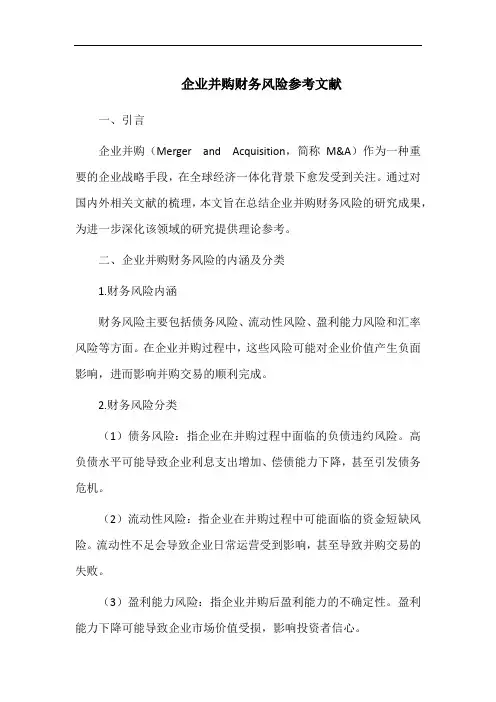
企业并购财务风险参考文献一、引言企业并购(Merger and Acquisition,简称M&A)作为一种重要的企业战略手段,在全球经济一体化背景下愈发受到关注。
通过对国内外相关文献的梳理,本文旨在总结企业并购财务风险的研究成果,为进一步深化该领域的研究提供理论参考。
二、企业并购财务风险的内涵及分类1.财务风险内涵财务风险主要包括债务风险、流动性风险、盈利能力风险和汇率风险等方面。
在企业并购过程中,这些风险可能对企业价值产生负面影响,进而影响并购交易的顺利完成。
2.财务风险分类(1)债务风险:指企业在并购过程中面临的负债违约风险。
高负债水平可能导致企业利息支出增加、偿债能力下降,甚至引发债务危机。
(2)流动性风险:指企业在并购过程中可能面临的资金短缺风险。
流动性不足会导致企业日常运营受到影响,甚至导致并购交易的失败。
(3)盈利能力风险:指企业并购后盈利能力的不确定性。
盈利能力下降可能导致企业市场价值受损,影响投资者信心。
(4)汇率风险:指企业在跨国并购中面临的汇率波动风险。
汇率波动可能对企业跨国经营的利润水平和现金流产生影响。
三、企业并购财务风险的影响因素与评估方法1.影响因素(1)企业内部因素:包括企业战略、治理结构、管理层能力等。
(2)市场环境因素:包括市场竞争、行业周期、政策法规等。
(3)外部融资环境因素:包括资本市场状况、信贷政策、利率水平等。
2.评估方法(1)财务比率分析:通过计算债务比率、流动比率、盈利比率等财务指标,评估企业并购财务风险。
(2)现金流量分析:分析企业现金流量状况,判断企业并购过程中的资金需求和流动性风险。
(3)事件研究法:通过分析并购事件对股价、汇率等市场因素的影响,评估企业并购财务风险。
四、企业并购财务风险的管理与控制策略1.债务风险管理:优化资本结构、加强债务监控、制定合理的利息支出预算等。
2.流动性风险管理:合理安排并购资金来源、加强现金流监控、制定应急预案等。

本科毕业论文外文资料翻译系别:经济系专业:会计学姓名:学号:年月日外文资料翻译译文并购的风险因素分析摘要:目的——目前世界市场经济的全球化趋势,这意味着公司合作和加强两国关系。
公司致力于发展当地市场没有许多可能性,所以合并和收购(并购)可以有机会为他们与来自世界各地的公司合作。
本文的主要目标是最重要的并购交易的风险因素。
这将是基于世界各地的一些著名的合并和收购的原因是什么写论文或研究的目的?设计/方法/方法——在欧洲和美国一些研究表明,许多并购注定要失败。
本文是基于研究的数据写的。
Selen,g·科尔文(2003)和s·杰克逊·r·舒勒(2002)。
也有相似的结论1998 - 2002年在波兰市场。
几乎40%的交易失败。
本文将比较一些合并和收购的案例。
发现这种分析的结果,考虑理论和实践解决方案,显示了并购失败的主要原因。
他们存在内部和外部风险因素。
并购的选择更短和更便宜的方式发展相当于传统的资本投资。
另一方面,他们有耗时和高风险的特点。
研究局限性——这项研究是基于一些世界并购流程指出主要的重点是这些交易的风险因素。
实际意义——本文的结论应该找对那些有兴趣的公司的领域投资。
它显示了本地和国际市场的主要威胁。
社会影响,本研究对社会的影响是什么?它将如何影响公众的态度?它将如何影响企业社会责任或环境问题?怎么通知公共或行业政策吗?它会如何影响生活质量?创意/价值——本文显示最重要的内部和外部风险因素。
了解那些方面可能非常有助于企业在并购交易过程中避免错误。
关键字:合并、收购、风险因素、整合、公司价值、金融风险、操作风险。
论文类型的观点介绍目前世界市场经济的特点是全球化趋势,这意味着公司合作和加强两国关系。
20世纪初以来的并购数量迅速增加不仅显现在世界经济中,而且在波兰这种情况更加明显。
21世纪的头两年的并购使世界各地的活力严重下降。
在2003年,这些交易的数量和金额又开始增长。
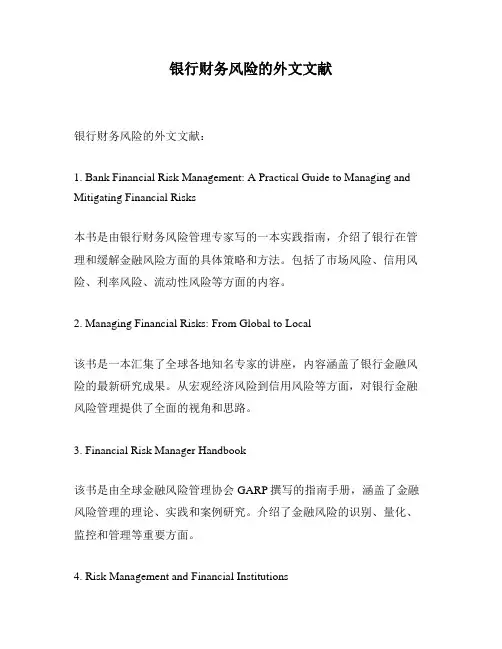
银行财务风险的外文文献银行财务风险的外文文献:1. Bank Financial Risk Management: A Practical Guide to Managing and Mitigating Financial Risks本书是由银行财务风险管理专家写的一本实践指南,介绍了银行在管理和缓解金融风险方面的具体策略和方法。
包括了市场风险、信用风险、利率风险、流动性风险等方面的内容。
2. Managing Financial Risks: From Global to Local该书是一本汇集了全球各地知名专家的讲座,内容涵盖了银行金融风险的最新研究成果。
从宏观经济风险到信用风险等方面,对银行金融风险管理提供了全面的视角和思路。
3. Financial Risk Manager Handbook该书是由全球金融风险管理协会GARP撰写的指南手册,涵盖了金融风险管理的理论、实践和案例研究。
介绍了金融风险的识别、量化、监控和管理等重要方面。
4. Risk Management and Financial Institutions该书是一本行业标准教材,由两位金融风险管理领域的权威合著,涉及了金融风险定义、评估和管理的关键内容。
书中还包括了现代金融和银行业的最新发展和趋势等方面的内容。
5. Financial Risk: Theory, Evidence and Implications该书是一本由多位学者合著的金融风险研究专著,旨在为银行业和投资机构等金融市场从业者提供有关金融风险识别和管理的理论和实践指南。
通俗易懂的语言介绍了金融市场的基本原则,包括风险、收益、投资组合构建和风险管理等重要方面。
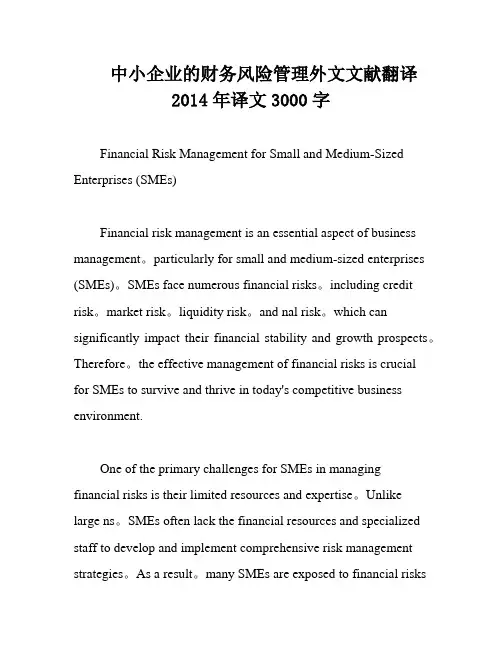
中小企业的财务风险管理外文文献翻译2014年译文3000字Financial Risk Management for Small and Medium-Sized Enterprises (SMEs)Financial risk management is an essential aspect of business management。
particularly for small and medium-sized enterprises (SMEs)。
SMEs face numerous financial risks。
including credit risk。
market risk。
liquidity risk。
and nal risk。
which can significantly impact their financial stability and growth prospects。
Therefore。
the effective management of financial risks is crucialfor SMEs to survive and thrive in today's competitive business environment.One of the primary challenges for SMEs in managing financial risks is their limited resources and expertise。
Unlike large ns。
SMEs often lack the financial resources and specialized staff to develop and implement comprehensive risk management strategies。
As a result。
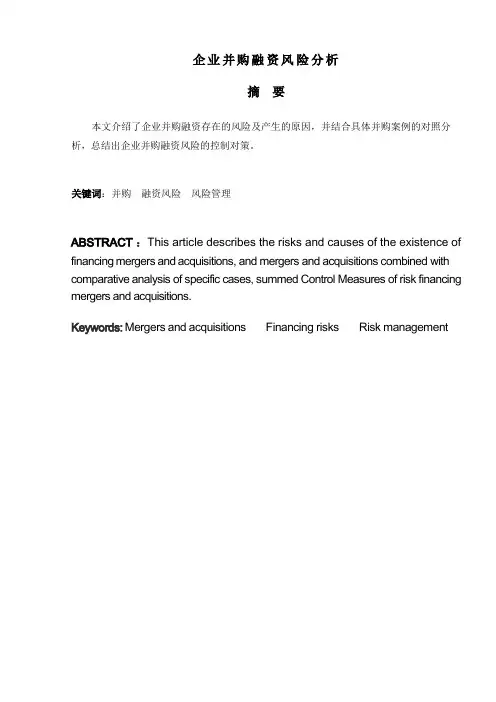
本文介绍了企业并购融资存在的风险及产生的原因,并结合具体并购案例的对照分 析,总结出企业并购融资风险的控制对策。
:并购 融资风险 风险管理 This article describes the risks and causes of the existence of financing mergers and acquisitions, and mergers and acquisitions combined with comparative analysis of specific cases, summed Control Measures of risk financing mergers and acquisitions.
Mergers and acquisitions Financing risks Risk management
随着经济全球化的深入,不少企业采取并购这一方式作为扩张的手段,并购已经成为 企业资本运营的重要方式之一。企业并购需要大量的资金周转,如果企业单靠自有资金的 支持,那末将难以完成并购,这就必须依靠外部融资来达成目标,这样,融资便成为企业 并购的一个重要环节。从我国企业的并购发展情况来看,在我国并购史上真正成功的案例 并非不少,大多数企业都以失败告终。总结这些失败案例,我们可以发现不少并购都是 在融资环节浮现了问题。为保证企业并购活动能够顺利开展,提高并购效率,必须对并购 融资风险进行管理。 基于上述背景,本文选择企业并购融资风险分析为题,从介绍并购融资风险的概念及 风险类型出发,解释风险产生的原因,并分析具体并购案例,通过对照不同案例中的融资 风险管理,总结出具体的管理对策。
每一个成功企业并购案例的暗地里,都需要雄厚的资金作为后盾,公司并购的资金筹集 环节会给企业带来融资风险。本章节介绍企业并购融资风险的概念、类型以及各种风险产 生的原因。
“企业并购融资风险是指与并购资金来源和融资后资本结构有关的资金来源风险” [1] ,具体包括融资在数量和时间上是否保证需要、融资方式是否符合并购动机以及是否影 响并购方的控制权、融资成本是否影响企业正常的经营等。 融资风险是因企业并购融资 是影响因素的不确定而客观存在的,并且不确定随融资量的增大而加大。
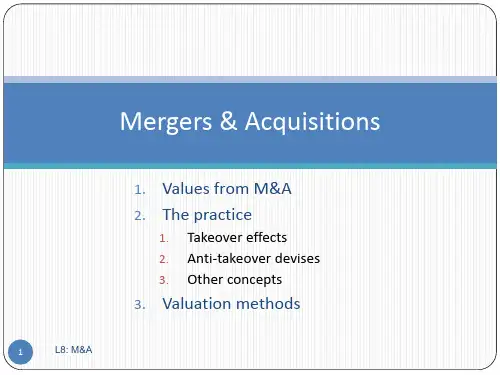
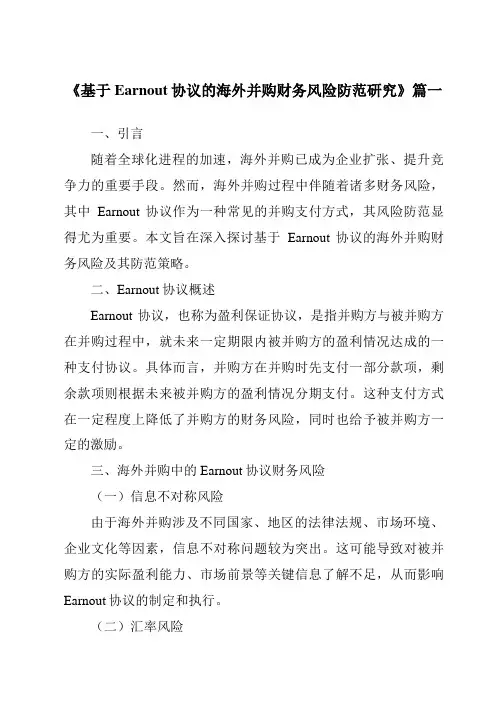
《基于Earnout协议的海外并购财务风险防范研究》篇一一、引言随着全球化进程的加速,海外并购已成为企业扩张、提升竞争力的重要手段。
然而,海外并购过程中伴随着诸多财务风险,其中Earnout协议作为一种常见的并购支付方式,其风险防范显得尤为重要。
本文旨在深入探讨基于Earnout协议的海外并购财务风险及其防范策略。
二、Earnout协议概述Earnout协议,也称为盈利保证协议,是指并购方与被并购方在并购过程中,就未来一定期限内被并购方的盈利情况达成的一种支付协议。
具体而言,并购方在并购时先支付一部分款项,剩余款项则根据未来被并购方的盈利情况分期支付。
这种支付方式在一定程度上降低了并购方的财务风险,同时也给予被并购方一定的激励。
三、海外并购中的Earnout协议财务风险(一)信息不对称风险由于海外并购涉及不同国家、地区的法律法规、市场环境、企业文化等因素,信息不对称问题较为突出。
这可能导致对被并购方的实际盈利能力、市场前景等关键信息了解不足,从而影响Earnout协议的制定和执行。
(二)汇率风险海外并购涉及不同国家的货币,汇率波动可能对Earnout协议的执行产生重大影响。
例如,若在协议执行过程中,货币汇率出现大幅波动,可能导致并购方支付更多的成本或无法按时足额收到应付款项。
(三)法律风险不同国家和地区的法律法规存在差异,可能导致Earnout协议的合法性、执行效力等问题。
若未充分了解当地法律法规或存在合同漏洞,可能给并购方带来财务风险。
四、Earnout协议财务风险防范策略(一)加强信息收集与评估为降低信息不对称风险,并购方应充分收集被并购方的相关信息,包括财务状况、市场前景、竞争优势等。
同时,应通过尽职调查等方式对信息进行评估,确保对被并购方的实际状况有充分了解。
(二)建立汇率风险管理机制为应对汇率风险,并购方应建立汇率风险管理机制,包括关注汇率市场动态、制定汇率风险管理策略、使用金融衍生工具等进行风险对冲等。
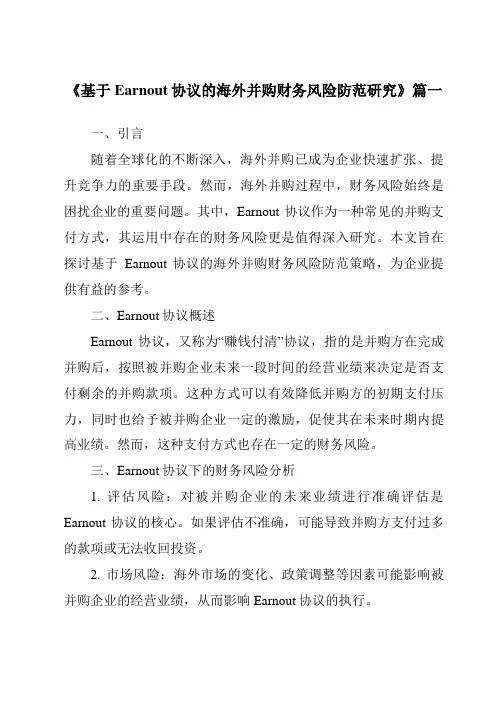
《基于Earnout协议的海外并购财务风险防范研究》篇一一、引言随着全球化的不断深入,海外并购已成为企业快速扩张、提升竞争力的重要手段。
然而,海外并购过程中,财务风险始终是困扰企业的重要问题。
其中,Earnout协议作为一种常见的并购支付方式,其运用中存在的财务风险更是值得深入研究。
本文旨在探讨基于Earnout协议的海外并购财务风险防范策略,为企业提供有益的参考。
二、Earnout协议概述Earnout协议,又称为“赚钱付清”协议,指的是并购方在完成并购后,按照被并购企业未来一段时间的经营业绩来决定是否支付剩余的并购款项。
这种方式可以有效降低并购方的初期支付压力,同时也给予被并购企业一定的激励,促使其在未来时期内提高业绩。
然而,这种支付方式也存在一定的财务风险。
三、Earnout协议下的财务风险分析1. 评估风险:对被并购企业的未来业绩进行准确评估是Earnout协议的核心。
如果评估不准确,可能导致并购方支付过多的款项或无法收回投资。
2. 市场风险:海外市场的变化、政策调整等因素可能影响被并购企业的经营业绩,从而影响Earnout协议的执行。
3. 信息不对称风险:由于信息不对称,并购方可能无法全面了解被并购企业的真实情况,导致决策失误。
4. 法律风险:不同国家的法律法规存在差异,可能影响Earnout协议的合法性和执行力。
四、财务风险防范策略1. 建立健全评估体系:企业应建立完善的评估体系,对被并购企业的财务状况、市场前景、核心竞争力等进行全面评估。
同时,应采用多种评估方法,以提高评估的准确性。
2. 做好市场调研:企业应充分了解海外市场的情况,包括政策、法律、文化等方面。
这有助于企业更好地预测被并购企业的未来业绩,降低市场风险。
3. 加强信息收集与筛选:企业应通过多种渠道收集被并购企业的信息,包括财务报告、行业报告、竞争对手分析等。
同时,应建立信息筛选机制,确保所收集的信息真实、准确、全面。
4. 制定合理的Earnout协议:企业应根据被并购企业的实际情况,制定合理的Earnout协议。
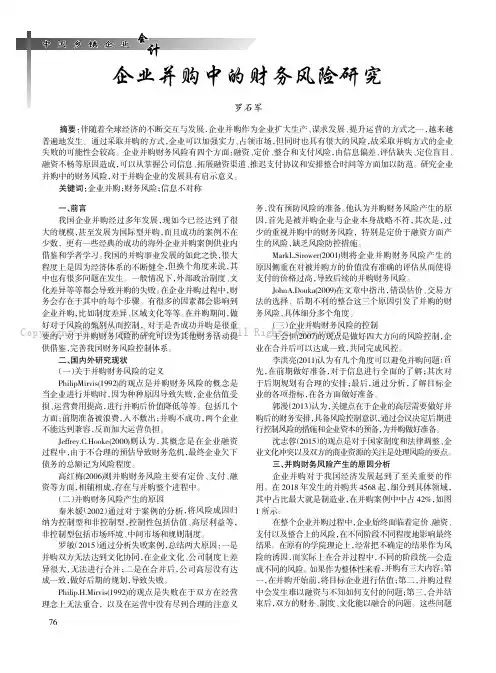
企业并购中的财务风险研究罗石军摘要:伴随着全球经济的不断交互与发展,企业并购作为企业扩大生产、谋求发展、提升运营的方式之一,越来越普遍地发生。
通过采取并购的方式,企业可以加强实力、占领市场,但同时也具有很大的风险,故采取并购方式的企业失败的可能性会较高。
企业并购财务风险有四个方面:融资、定价、整合和支付风险,由信息偏差、评估缺失、定位盲目、融资不畅等原因造成,可以从掌握公司信息、拓展融资渠道、推迟支付协议和安排整合时间等方面加以防范。
研究企业并购中的财务风险,对于并购企业的发展具有启示意义。
关键词:企业并购;财务风险;信息不对称一、前言我国企业并购经过多年发展,现如今已经达到了很大的规模,甚至发展为国际型并购,而且成功的案例不在少数,更有一些经典的成功的海外企业并购案例供业内借鉴和学者学习。
我国的并购事业发展的如此之快,很大程度上是因为经济体系的不断健全,但换个角度来说,其中也有很多问题在发生。
一般情况下,外部政治制度、文化差异等等都会导致并购的失败。
在企业并购过程中,财务会存在于其中的每个步骤。
有很多的因素都会影响到企业并购,比如制度差异、区域文化等等。
在并购期间,做好对于风险的甄别从而控制,对于是否成功并购是很重要的,对于并购财务风险的研究可以为其他财务活动提供借鉴,完善我国财务风险控制体系。
二、国内外研究现状(一)关于并购财务风险的定义PhilipMirvis(1992)的观点是并购财务风险的概念是当企业进行并购时,因为种种原因导致失败,企业估值受损、运营费用提高,进行并购后价值降低等等。
包括几个方面:前期准备被浪费,入不敷出;并购不成功,两个企业不能达到兼容,反而加大运营负担。
Jeffrey.C.Hooke(2000)则认为,其概念是在企业融资过程中,由于不合理的预估导致财务危机,最终企业欠下债务的总额记为风险程度。
高红梅(2006)则并购财务风险主要有定价、支付、融资等方面,相辅相成,存在与并购整个进程中。
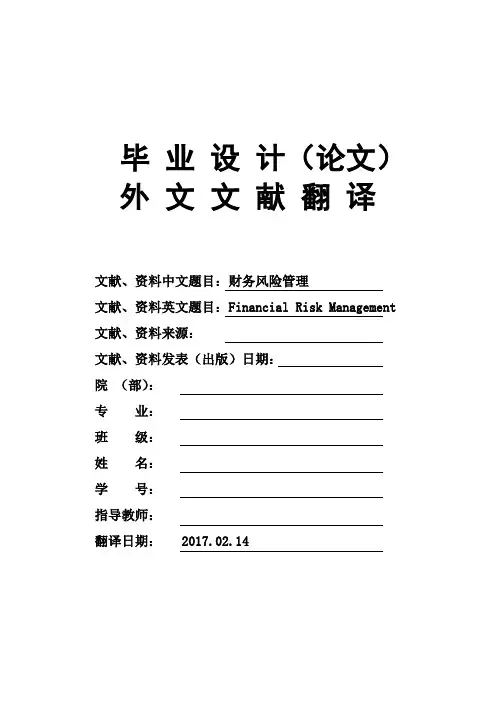
毕业设计(论文)外文文献翻译文献、资料中文题目:财务风险管理文献、资料英文题目:Financial Risk Management 文献、资料来源:文献、资料发表(出版)日期:院(部):专业:班级:姓名:学号:指导教师:翻译日期: 2017.02.14财务管理类本科毕业论文外文翻译译文:[美]卡伦·A·霍契.《什么是财务风险管理?》.《财务风险管理要点》.约翰.威立国际出版公司,2005:P1-22.财务风险管理尽管近年来金融风险大大增加,但风险和风险管理不是当代的主要问题。
全球市场越来越多的问题是,风险可能来自几千英里以外的与这些事件无关的国外市场。
意味着需要的信息可以在瞬间得到,而其后的市场反应,很快就发生了。
经济气候和市场可能会快速影响外汇汇率变化、利率及大宗商品价格,交易对手会迅速成为一个问题。
因此,重要的一点是要确保金融风险是可以被识别并且管理得当的。
准备是风险管理工作的一个关键组成部分。
什么是风险?风险给机会提供了基础。
风险和暴露的条款让它们在含义上有了细微的差别。
风险是指有损失的可能性,而暴露是可能的损失,尽管他们通常可以互换。
风险起因是由于暴露。
金融市场的暴露影响大多数机构,包括直接或间接的影响。
当一个组织的金融市场暴露,有损失的可能性,但也是一个获利或利润的机会。
金融市场的暴露可以提供战略性或竞争性的利益。
风险损失的可能性事件来自如市场价格的变化。
事件发生的可能性很小,但这可能导致损失率很高,特别麻烦,因为他们往往比预想的要严重得多。
换句话说,可能就是变异的风险回报。
由于它并不总是可能的,或者能满意地把风险消除,在决定如何管理它中了解它是很重要的一步。
识别暴露和风险形式的基础需要相应的财务风险管理策略。
财务风险是如何产生的呢?无数金融性质的交易包括销售和采购,投资和贷款,以及其他各种业务活动,产生了财务风险。
它可以出现在合法的交易中,新项目中,兼并和收购中,债务融资中,能源部分的成本中,或通过管理的活动,利益相关者,竞争者,外国政府,或天气出现。
外文原文How Important is Financial Risk?作者:Sohnke M. Bartram, Gregory W. Brown, and Murat Atamer起止页码:1-7出版日期(期刊号):September 2009,V ol. 2, No. 4(Serial No. 11)出版单位:Theory and Decision, DOI 10.1007/s11238-005-4590-0Abstract:This paper examines the determinants of equity price risk for a large sample of non-financial corporations in the United States from 1964 to 2008. We estimate both structural and reduced form models to examine the endogenous nature of corporate financial characteristics such as total debt, debt maturity, cash holdings, and dividend policy. We find that the observed levels of equity price risk are explained primarily by operating and asset characteristics such as firm age, size, asset tangibility, as well as operating cash flow levels and volatility. In contrast, implied measures of financial risk are generally low and more stable than debt-to-equity ratios. Our measures of financial risk have declined over the last 30 years even as measures of equity volatility (e.g. idiosyncratic risk) have tended to increase. Consequently, documented trends in equity price risk are more than fully accounted for by trends in the riskiness of firms’ assets. Taken together, the results suggest that the typical U.S. firm substantially reduces financial risk by carefully managing financial policies. As a result, residual financial risk now appears negligible relative to underlying economic risk for a typical non-financial firm.Keywords:Capital structure;financial risk;risk management;corporate finance 1IntroductionThe financial crisis of 2008 has brought significant attention to the effects of financial leverage. There is no doubt that the high levels of debt financing by financial institutions and households significantly contributed to the crisis. Indeed, evidence indicates that excessive leverage orchestrated by major global banks (e.g., through the mortgage lending and collateralized debt obligations) and the so-called “shadow banking system” may be the underlying cause of the recent economic and financial dislocation. Less obvious is the role of financial leverage among nonfinancial firms. To date, problems in the U.S. non-financial sector have been minor compared to thedistress in the financial sector despite the seizing of capital markets during the crisis. For example, non-financial bankruptcies have been limited given that the economic decline is the largest since the great depression of the 1930s. In fact, bankruptcy filings of non-financial firms have occurred mostly in U.S. industries (e.g., automotive manufacturing, newspapers, and real estate) that faced fundamental economic pressures prior to the financial crisis. This surprising fact begs the question, “How important is financial risk for non-financial firms?” At the heart of this issue is the uncertainty about the determinants of total firm risk as well as components of firm risk.Recent academic research in both asset pricing and corporate finance has rekindled an interest in analyzing equity price risk. A current strand of the asset pricing literature examines the finding of Campbell et al. (2001) that firm-specific (idiosyncratic) risk has tended to increase over the last 40 years. Other work suggests that idiosyncratic risk may be a priced risk factor (see Goyal and Santa-Clara, 2003, among others). Also related to these studies is work by Pástor and Veronesi (2003) showing how investor uncertainty about firm profitability is an important determinant of idiosyncratic risk and firm value. Other research has examined the role of equity volatility in bond pricing (e.g., Dichev, 1998, Campbell, Hilscher, and Szilagyi, 2008).However, much of the empirical work examining equity price risk takes the risk of assets as given or tries to explain the trend in idiosyncratic risk. In contrast, this paper takes a different tack in the investigation of equity price risk. First, we seek to understand the determinants of equity price risk at the firm level by considering total risk as the product of risks inherent in the firms operations (i.e., economic or business risks) and risks associated with financing the firms operations (i.e., financial risks). Second, we attempt to assess the relative importance of economic and financial risks and the implications for financial policy.Early research by Modigliani and Miller (1958) suggests that financial policy may be largely irrelevant for firm value because investors can replicate many financial decisions by the firm at a low cost (i.e., via homemade leverage) and well-functioning capital markets should be able to distinguish between financial and economic distress. Nonetheless, financial policies, such as adding debt to the capital structure, can magnify the risk of equity. In contrast, recent research on corporate risk management suggests that firms may also be able to reduce risks and increase valuewith financial policies such as hedging with financial derivatives. However, this research is often motivated by substantial deadweight costs associated with financial distress or other market imperfections associated with financial leverage. Empirical research provides conflicting accounts of how costly financial distress can be for a typical publicly traded firm.We attempt to directly address the roles of economic and financial risk by examining determinants of total firm risk. In our analysis we utilize a large sample of non-financial firms in the United States. Our goal of identifying the most important determinants of equity price risk (volatility) relies on viewing financial policy as transforming asset volatility into equity volatility via financial leverage. Thus, throughout the paper, we consider financial leverage as the wedge between asset volatility and equity volatility. For example, in a static setting, debt provides financial leverage that magnifies operating cash flow volatility. Because financial policy is determined by owners (and managers), we are careful to examine the effects of firms’ asset and operating characteristics on financial policy. Specifically, we examine a variety of characteristics suggested by previous research and, as clearly as possible, distinguish between those associated with the operations of the company (i.e. factors determining economic risk) and those associated with financing the firm (i.e. factors determining financial risk). We then allow economic risk to be a determinant of financial policy in the structural framework of Leland and Toft (1996), or alternatively, in a reduced form model of financial leverage. An advantage of the structural model approach is that we are able to account for both the possibility of financial and operating implications of some factors (e.g., dividends), as well as the endogenous nature of the bankruptcy decision and financial policy in general.Our proxy for firm risk is the volatility of common stock returns derived from calculating the standard deviation of daily equity returns. Our proxies for economic risk are designed to capture the essential characteristics of the firms’ operations and assets that determine the cash flow generating process for the firm. For example, firm size and age provide measures of line of- business maturity; tangible assets (plant, property, and equipment) serve as a proxy for the ‘hardness’ of a firm’s assets; capital expenditures measure capital intensity as well as growth potential. Operating profitability and operating profit volatility serve as measures of the timeliness and riskiness of cash flows. To understand how financial factors affect firm risk, we examine total debt, debt maturity, dividend payouts, and holdings of cash andshort-term investments.The primary result of our analysis is surprising: factors determining economic risk for a typical company explain the vast majority of the variation in equity volatility. Correspondingly, measures of implied financial leverage are much lower than observed debt ratios. Specifically, in our sample covering 1964-2008 average actual net financial (market) leverage is about 1.50 compared to our estimates of between 1.03 and 1.11 (depending on model specification and estimation technique). This suggests that firms may undertake other financial policies to manage financial risk and thus lower effective leverage to nearly negligible levels. These policies might include dynamically adjusting financial variables such as debt levels, debt maturity, or cash holdings (see, for example, Acharya, Almeida, and Campello, 2007). In addition, many firms also utilize explicit financial risk management techniques such as the use of financial derivatives, contractual arrangements with investors (e.g. lines of credit, call provisions in debt contracts, or contingencies in supplier contracts), special purpose vehicles (SPVs), or other alternative risk transfer techniques.The effects of our economic risk factors on equity volatility are generally highly statistically significant, with predicted signs. In addition, the magnitudes of the effects are substantial. We find that volatility of equity decreases with the size and age of the firm. This is intuitive since large and mature firms typically have more stable lines of business, which should be reflected in the volatility of equity returns. Equity volatility tends to decrease with capital expenditures though the effect is weak. Consistent with the predictions of Pástor and Veronesi (2003), we find that firms with higher profitability and lower profit volatility have lower equity volatility. This suggests that companies with higher and more stable operating cash flows are less likely to go bankrupt, and therefore are potentially less risky. Among economic risk variables, the effects of firm size, profit volatility, and dividend policy on equity volatility stand out. Unlike some previous studies, our careful treatment of the endogeneity of financial policy confirms that leverage increases total firm risk. Otherwise, financial risk factors are not reliably related to total risk.Given the large literature on financial policy, it is no surprise that financial variables are,at least in part, determined by the economic risks firms take. However, some of the specific findings are unexpected. For example, in a simple model of capital structure, dividend payouts should increase financial leverage since they represent an outflow of cash from the firm (i.e., increase net debt). We find thatdividends are associated with lower risk. This suggests that paying dividends is not as much a product of financial policy as a characteristic of a firm’s operations (e.g., a mature company with limited growth opportunities). We also estimate how sensitivities to different risk factors have changed over time. Our results indicate that most relations are fairly stable. One exception is firm age which prior to 1983 tends to be positively related to risk and has since been consistently negatively related to risk. This is related to findings by Brown and Kapadia (2007) that recent trends in idiosyncratic risk are related to stock listings by younger and riskier firms.Perhaps the most interesting result from our analysis is that our measures of implied financial leverage have declined over the last 30 years at the same time that measures of equity price risk (such as idiosyncratic risk) appear to have been increasing. In fact, measures of implied financial leverage from our structural model settle near 1.0 (i.e., no leverage) by the end of our sample. There are several possible reasons for this. First, total debt ratios for non-financial firms have declined steadily over the last 30 years, so our measure of implied leverage should also decline. Second, firms have significantly increased cash holdings, so measures of net debt (debt minus cash and short-term investments) have also declined. Third, the composition of publicly traded firms has changed with more risky (especially technology-oriented) firms becoming publicly listed. These firms tend to have less debt in their capital structure. Fourth, as mentioned above, firms can undertake a variety of financial risk management activities. To the extent that these activities have increased over the last few decades, firms will have become less exposed to financial risk factors.We conduct some additional tests to provide a reality check of our results. First, we repeat our analysis with a reduced form model that imposes minimum structural rigidity on our estimation and find very similar results. This indicates that our results are unlikely to be driven by model misspecification. We also compare our results with trends in aggregate debt levels for all U.S. non-financial firms and find evidence consistent with our conclusions. Finally, we look at characteristics of publicly traded non-financial firms that file for bankruptcy around the last three recessions and find evidence suggesting that these firms are increasingly being affected by economic distress as opposed to financial distress.In short, our results suggest that, as a practical matter, residual financial risk is now relatively unimportant for the typical U.S. firm. This raises questions about the level of expected financial distress costs since the probability of financial distress islikely to be lower than commonly thought for most companies. For example, our results suggest that estimates of the level of systematic risk in bond pricing may be biased if they do not take into account the trend in implied financial leverage (e.g., Dichev, 1998). Our results also bring into question the appropriateness of financial models used to estimate default probabilities, since financial policies that may be difficult to observe appear to significantly reduce risk. Lastly, our results imply that the fundamental risks born by shareholders are primarily related to underlying economic risks which should lead to a relatively efficient allocation of capital.Before proceeding we address a potential comment about our analysis. Some readers may be tempted to interpret our results as indicating that financial risk does not matter. This is not the proper interpretation. Instead, our results suggest that firms are able to manage financial risk so that the resulting exposure to shareholders is low compared to economic risks. Of course, financial risk is important to firms that choose to take on such risks either through high debt levels or a lack of risk management. In contrast, our study suggests that the typical non-financial firm chooses not to take these risks. In short, gross financial risk may be important, but firms can manage it. This contrasts with fundamental economic and business risks that are more difficult (or undesirable) to hedge because they represent the mechanism by which the firm earns economic profits.The paper is organized at follows. Motivation, related literature, and hypotheses are reviewed in Section 2. Section 3 describes the models we employ followed by a description of the data in Section 4. Empirical results for the Leland-Toft model are presented in Section 5. Section 6 considers estimates from the reduced form model, aggregate debt data for the no financial sector in the U.S., and an analysis of bankruptcy filings over the last 25 years. Section 6 concludes.2 Motivation, Related Literature, and HypothesesStudying firm risk and its determinants is important for all areas of finance. In the corporate finance literature, firm risk has direct implications for a variety of fundamental issues ranging from optimal capital structure to the agency costs of asset substitution. Likewise, the characteristics of firm risk are fundamental factors in all asset pricing models.The corporate finance literature often relies on market imperfections associated with financial risk. In the Modigliani Miller (1958) framework, financial risk (or more generally financial policy) is irrelevant because investors can replicate the financialdecisions of the firm by themselves. Consequently, well-functioning capital markets should be able to distinguish between frictionless financial distress and economic bankruptcy. For example, Andrade and Kaplan (1998) carefully distinguish between costs of financial and economic distress by analyzing highly leveraged transactions, and find that financial distress costs are small for a subset of the firms that did not experience an “economic” shock. They conclude that financial distress costs should be small or insignificant for typical firms. Kaplan and Stein (1990) analyze highly levered transactions and find that equity beta increases are surprisingly modest after recapitalizations.The ongoing debate on financial policy, however, does not address the relevance of financial leverage as a driver of the overall riskiness of the firm. Our study joins the debate from this perspective. Correspondingly, decomposing firm risk into financial and economic risks is at the heart of our study.Research in corporate risk management examines the role of total financial risk explicitly by examining the motivations for firms to engage in hedging activities. In particular, theory suggests positive valuation effects of corporate hedging in the presence of capital market imperfections. These might include agency costs related to underinvestment or asset substitution (see Bessembinder, 1991, Jensen and Meckling, 1976, Myers, 1977, Froot, Scharfstein, and Stein,1993), bankruptcy costs and taxes (Smith and Stulz, 1985), and managerial risk aversion (Stulz,1990). However, the corporate risk management literature does not generally address the systematic pricing of corporate risk which has been the primary focus of the asset pricing literature.Lintner (1965) and Sharpe (1964) define a partial equilibrium pricing of risk in a mean variance framework. In this structure, total risk is decomposed into systematic risk and idiosyncratic risk, and only systematic risk should be priced in a frictionless market. However, Campbelletal (2001) find that firm-specific risk has increased substantially over the last four decades and various studies have found that idiosyncratic risk is a priced factor (Goyal and Santa Clara,2003, Ang, Hodrick, Xing, and Zhang, 2006, 2008, Spiegel and Wang, 2006). Research has determined various firm characteristics (i.e., industry growth rates, institutional ownership, average firm size, growth options, firm age, and profitability risk) are associated with firm-specific risk. Recent research has also examined the role of equity price risk in the context of expected financial distress costs (Campbell and Taksler, 2003, Vassalou and Xing, 2004, Almeida and Philippon, 2007, among others). Likewise, fundamental economicrisks have been shown to be to be related to equity risk factors (see, for example, Vassalou, 2003, and the citations therein). Choiand Richardson (2009) examine the volatility of the firm’s assets using issue-level data on debt and find that asset volatilities exhibit significant time-series variation and that financial leverage has a substantial effect on equity volatility.How Important is Financial Risk?财务风险的重要性作者:Sohnke M. Bartram, Gregory W. Brown, and Murat Atamer起始页码:1-7出版日期(期刊号):September 2009,Vol. 2, No. 4(Serial No. 11)出版单位:Theory and Decision, DOI 10.1007/s11238-005-4590-0外文翻译译文:摘要:本文探讨了美国大型非金融企业从1964年至2008年股票价格风险的决定小性因素。
中英文资料外文翻译文献上市公司财务风险的评价及控制的文献综述中国从资本市场建立开始,上市公司也随之不断地发展,上市的公司从行业、类型到地区、规模都呈现多样化趋势。
中国的上市公司,特别是上市公司中的ST公司,存在着严重的财务风险问题,财务风险比较大,对上市公司的发展会有很大的影响。
因此对上市公司财务风险问题的研究是十分重要的。
通过对这一领域大量文献的研究,从企业财务风险的成因、评价体系及控制三个角度综述,加强分析,以期对上市公司财务风险的理论和实践研究提供借鉴和指导。
(一)国外研究综述西方古典经济学家在十九世纪就已经提出了风险的概念,认为风险是经营活动的副产品,经营者的收入是其在经营活动中承担风险的报酬。
从狭义上看,企业的财务风险是指由于利用负债给企业带来的破产风险或普通股收益发生大幅度变动的风险。
这种观点立足于企业筹资时过多举债或举债不当。
西方国家强调全面风险管理的观念是从资金运动到资本经营整个体系的过程,对财务风险的控制包括风险预警、风险识别、危机处理等内容。
美国经济学家富兰克.H.奈特(Frank H.Knight)在1921年出版的(Risk,Uncertainty and Profit)一书中认为:风险是指“可度量的不确定性”。
而“不确定性”是指不可度量的风险。
风险的特征是概率估计的可靠性,概率估计的可靠性来自所遵循的理论规律或稳定的经验规律。
与可计算或可预见的风险不同,不确定性是指人们缺乏对事件的基本知识,对事件可能的结果知之甚少,因此,不能通过现有理论或经验进行预见和定量分析①。
②Ross, Westerfield, Jordan(1995)在《Fundamentals of Corporate Finance》提到①[美] Frank H.Knight,王宇,王文玉译.《风险、不确定性和利润》[M].中国人民大学出版社.2005;②此段原文如下:“The debt finacing increases the risks borne by the stockholders. The extra risk that arises from the use of debt finacing is called the financial risk of the firm equity. In other word,financial risk is the equity risk债务筹资会增加股东的风险,使用债务筹资所产生的这部分额外风险称为公司股东的财务风险。
文献出处:Błach J. Financial Risk Identification Based on the Balance Sheet Information[J]. Managing and Modelling of Financial Risks, 2016,1: 10-19.第一部分为译文,第二部分为原文。
默认格式:中文五号宋体,英文五号Times New Roma,行间距1.5倍。
基于资产负债表信息的财务风险识别摘要:现代经济风险暴露不断增加,所有企业都要承担不同类型的风险。
本文研究财务风险的定义,组成部分,因素和后果,以及通过资产负债表提供的信息的使用来识别和分析财务风险。
此外,还介绍了这种财务风险评估方法的优缺点,以100个最大波兰公司10年(2000-2009年)的汇总数据为例,测试了根据资产负债表信息确定财务风险的潜力。
关键词:财务风险,财务分析,风险评估,资产负债表。
1. 引言现代社会往往被描述为“风险社会”,这意味着社会的财富生产伴随着社会风险生产。
因此,在这种环境下经营的企业,被迫采取不同类型的风险识别,以发展自己,提高效率。
考虑到不同类型的标准,有各种各样的企业风险进行分析和分类。
企业风险最重要的类型之一是财务风险。
2.财务风险定义及其组成部分文献中没有统一的财务风险定义。
但问题始于风险的一般定义。
在理论上,提出了风险定义的两个概念。
第一个-负面概念将风险描述为潜在损失的威胁。
第二个-中立概念表明,风险不仅是威胁,也是机会,所以风险意味着获得不同于预期的结果的可能性。
因此,风险的定义主要取决于风险的方法,并且可能导致管理者采取的不同行动。
如果采取负面做法,管理人员的主要目标是尽可能减少潜在的损失,并设法避免危险行为,以稳定公司的情况。
在第二种情况下,经理们不仅要尽量减少损失,还要尽量利用承担风险,改善公司状况。
因此,可以从中性或消极的角度分析任何类型的风险的金融风险。
---文档均为word文档,下载后可直接编辑使用亦可打印--- 摘要:经济全球化时代,我国资本市场逐渐发展成熟,企业并购已经变成企业有效增加自身竞争力的主要方法;但是,这也加大了财务风险发生的概率。
本文以蒙牛集团并购雅士利国际为例,对企业并购所发生财务风险进行分析且得出防范手段,望能够为企业并购提供实践支持,以期达到对企业并购财务风险的指导和借鉴意义。
关键词:财务风险;企业并购;蒙牛乳业Financial risks and preventive measures of enterprise mergers and acquisitions —— a case study of mengniu's merger andacquisition of yasiliAuthor: Wang XinTutor: Zou Jiaxing(Oriental Science &Technology College of Hunan Agricultural University, Changsha 410128)Abstract: in the era of economic globalization, China's capital market is gradually developing and maturing, and enterprise merger and acquisition has become the main way for enterprises to effectively improve their competitiveness. At the s e m a ti n e, this is al os acco n mpanied by the o n ccurrence of fin n ancial ri n sk. Ta n king mengniu's m n erger n and acqui n sition of ya n sili as an exam n ple, this pa n per ana n lyzes the financ n ial ri n sks of ent n erprise n merger and acquisit n ion and dra n ws prev n entive me n asures, hopin n g to prov n ide practi n cal supp n ort for enterp n rise merge n r and acqu n isition, so as to provi n de guidan n ce and refer n ence for enterpri n se m n erger and acq n uisition of fina n ncial ri n ks.Key words:Financial R isk; Enterprise M erger and A cquisition; Mengniu D airy一、绪论(一)研究背景与意义企业之间的合并与收购行为,是一中风险极高的经营活动,风险贯穿于并购活动的始终,本文以蒙牛集团并购雅士利国际为例,对企业并购的财务风险进行分析并且得到防范措施,希望可以为以后企业的并购提供游泳的实践支持,以达到对企业并购财务风险的指导和参考的意义。
中文3270字 JohnA . Douka,International Journal of business and management[J]January2009
并购的财务风险研究 摘要 并购是一个高风险的活动。并购业务,无论是在准备阶段,还是在合并的运营阶段,或之后的整合阶段,将伴随着大量的不确定性。这些跨国并购所带来的不确定性有可能导致巨大的财务风险。尤其在当前,更多的国内企业已经选择了并购这条路。本文对并购的各个重点阶段容易受到的财务风险分析,并对这些风险提出了防范措施。 关键词:并购,财务风险,防范措施 在西方国家,并购有大约超过100年的历史,交易规模不断扩大。2000年,在我国,第五次全球并购浪潮达到一个高峰,并购在我国越来越受欢迎。例如,许多公司加快海外扩张和并购的步伐,许多企业选择并购来渡过难关。正如我们所知道的,并购一定会有风险,比如:目标公司的评估,交易方法,或财务风险的选择。如何才能避免这些风险?我们要选择哪种方法?这就是这篇文章的目的。 1.并购导致财务风险的原因 1.1高估或低估了公司价值带来的风险 1.1.1信息不对称是影响估计的主要因素 由于信息不对称,目标公司一直隐瞒不良信息和夸大良好的信息。投标人还夸大自己的实力,他们所披露的情况不足或失真。因此,贸然行动的失败结果随处可见。有很多有关风险的资料,两个重要的例子就是:第一,股票风险,公平对任何一家公司都是很重要的,但所提供的信息和真实情况之间存在着差异,这些虚假的信息威胁到并购的成功;第二,债务信息的风险,如果没有发现这种风险,庞大的债务将毫无缘由的转嫁到投标人身上。 1.1.2缺乏合理的评估方法 有三种评估方法:成本法、市场法、收益法,这其中,市场法要求有关信息的对称性要高,只有当信息评价具有高对称性时才可以对企业作出准确判断。然而,在我国,信息对称水平低,小企业采用这种方法。他们大多采用替代法和收益法。这两个方法也有缺点,重置成本反映历史成本,不能反映未来盈利能力;就算把现值看做增值的收入,它也明显的缺陷,那就是,未来的收入预期是不同的。 1
1.1.3评估体系不健全 这是在整个行业中的一种评估制度,而不是一个简单的方法。目前,我国缺少独立、专业的团体,海外并购多数由企业自行完成,在这点上是有一定程度的不合理。由于缺乏专业技能,且没有长期随访观察的习惯,并不能得到长期、稳定的信息等等,这一切导致了评估结果不能按照预期发展。 1.2交易方式的选择导致的风险 1.2.1现金方法 如果你不期望在现金支付中有风险,就必须使增加的预期现金流的净现值大于所支付的,而投标人的股东将承担损失。当现金付款的成本扩大,面临着巨大的债务负担,并且最后期限的资金来源结构不合理,或缺乏短期融资,很容易带来收购的流动性压力。此时如果有一个新公司流动性资产水平低,就会产生流动性风险,而流动性风险最突出的是通过现金付款体现的。 1.2.2支付普通股 整体而言,股票支付的主要风险来自增值的期望,股东交易所扩大股东的基础,导致了每股收益下降,因为稀释了每股收益,投资者会怀疑目标公司取回每股收益的能力下降,投标人的股票价格将下降。这表明从该可转换股权稀释的比例是造成支付风险的最重要手段。 1.2.3杠杆付款 杠杆将不可避免地带来债务风险。杠杆是投标人作出贷款,向银行抵押企业资产,合并后的生产和经营活动产生的现金将成功偿还贷款。其杠杆付款方式目的是通过贷款解决使用贷款的资金问题,并希望收购能得到有效的杠杆效益。这种方法必将实现高的投资回报,这需要稳定的现金流来完成。否则,因为无法还清了更高的债务,收购公司可能会破产。 1.3合并后的整合不利导致财务风险 在整合期间,当风险因素作用到一定程度时,这将导致财务风险的发生。根据表现,财务风险可以分为机制风险,财务风险和经营风险。机制风险意味在整合时期,由于设立了金融机构,财政职能,财政管理体制,金融机构的更新,金融的协同作用和其他因素,财政收入和投标人的预期财政收益发生偏离并因此遭受到的损失。财务风险是指如果当金融运行有错误,财政收入和财政税收将脱离预期。在资产管理过程中,投标人控制他们的资产、成本、金融业务、负债、利润和其他财务职能,按照实现协同收入最大化的原理是为了实现跨国并购成功的的最终目的。然而,不确定性的宏观和微观环境的,影响着财务运作,从而导致财务风险。经营风险是指金融活动的监管不足,导致财务风险的结果。 这说明并购进程的结束并不等于最后的成功,金融一体化是财务管理的结 2
束,也是最重要的方面,如果失败就意味着整个并购是失败的。 2.财务风险防范措施 2.1防范信息风险 这主要作用是通过合理,有效的方法排除虚假信息然后获得真正的,全面的信息。对于股票的风险,有两个要点:适当谨慎和披露。适当的谨慎是指调查,审查和评价过程。投标人必须调查目标公司外部和内部的情况,以便找到一些限制产权交易的政府活动。信息披露是指目标公司应该告诉诸如投标人的有关材料,信息,债权债务等。信息披露必须真实,完整,没有误导成分。至于债务风险,我们必须首先选择最好的方法;第二,你必须与有关的债务范围达成一致。 2.2建立完善的评价体系,并选择适当的评估方法 适当的评价方法通常包括两个系统的评价:一个是基本系统,包括财务分析,业内人士分析,运行情况分析。金融体系的分析有助于理解双方财政状况,业内人士分析系统,可以使投标人了解了外部环境,以及行业发展趋势的状态。通过对经营状况分析,可以了解存在的问题,操作并提供了整合的基础。在此基础上,企业才能避免这种风险。 二是评价体系。有很多评价体系的方法,正如账面价值,市场价值,清算价值,贴现现金流量等。不同的评估方法会导致不同的价格,因此企业应根据自己的动机,选择更好的方法。 2.3选择灵活的付款方式 在付款方式上合理安排和减少财务费用,是与该付款方式有关,其中现金支付面临最大压力。并购企业可以结合自己的现有资源,稀释每股收益和股票价格波动,在股权结构的变化,以便使他们发放现金,债券和股票的组合,使其能满足双方的需要。例如,并购需要两层付款方式,在第二个步骤,采取现金方式的混合方法。此付款,在一方面,由于交易规模,买方支付现金对价的能力有限,应保持一个比较合理的资本结构,以减少对贷款的巨大压力,另一方面,投标人可以诱导目标公司股东尽快作出出售决定,接着就可以达到取得对目标企业控制的目的。 2.4加强并购后的整合 2.4.1加强财务控制,人力资源,金融机构和金融一体化的功能 例如,兼并和收购业务,任命首席财务总监,在日常的日常财务活动,财务主任明确责任和权力,他们发挥对并购业务的组织和监督作用,并享有对整个企业所涉及的重大事件的决策权;并购实施调整,资源的分配,重大投资,技术结构发展和其他重大决策权的企业并购,预算的重大决策的监测和控制各种类型的预算执行情况,并审核其财务报告;负责人事管理业务的的财务会计,定期报告 3
并购的资产经营和财务状况。与此同时,当收购完成后,金融机构应改善其组织的具体情况,包括财务会计制度,内部控制制度,投资和融资制度,使其更符合双方的需要,并建立一个统一的金融信息平台,以便使能更快,更准确和更全面的管理,使得所有类型的财务信息得以满足决策的需求。 2.4.2财务管理一体化 财务管理的目标是财务工作的出发点和归宿点,其结果影响到金融体系的理论,将决定一个财务决策的各种选择。一旦并购完成后,企业应该在目标公司财务方面做一个财务管理基础上的明确目标。 2.4.3整合资产和负债 在并购业务,投标人的债务可能增加,因为在接管时所采取的债务等方法只是为贷款和发行债券。如果资本结构不合理,金融形势也变得恶化。因此旨在改善财务状况的综合平衡和加强企业的偿付能力。 2.4.4为了加强企业管理的风险意识,建立和完善金融风险的预测和监控 若要提高风险管理业务的认识,将从源头防范并购的财务风险。此外,建立企业内部自己的财务风险防范和控制系统,加强企业对并购风险的预测是建立早期预警机制的关键领域之一。 综上所述,并购作为一种扩展业务规模,转变市场策略,调整社会经济结构和资源优化配置的更好更独特的方式,因而成为一个很受关注的话题,财务风险由并购产生的,因此也在各领域引起了深人广泛的讨论。随着市场的成熟,我认为并购活动的研究将更加深入,对并购和其财务风险问题将得到进一步深化,实现真正意义上的理论指导实践。
注:图表、致谢及参考文献已略去(见原文)。 4
International Journal of business and management[J]January2009 The Study of Financial Risk in M&A JohnA . Douka Abstract M &A is a risky activity. M & A business, whether in the preparation stage, or in the operational phase of the merger, or post-integration phase, will be accompanied by a large number of uncertainties. These uncertainties brought about by mergers and acquisitions could lead to a huge financial risk. In particular, more domestic enterprises have chosen the path of M & A. This article focuses on the various stages of the merger vulnerable to financial risks, and risks of these raised a number of preventive measures. Keywords: M&A, Financial risk, Preventive measures In the west countries, M&A have a history about more than 100 years, and transactions have been expanding. The 5th wave of global mergers and acquisitions peaked in 2000.In our country, M&A become more and more popular. For example, many companies step up the pace of overseas expansion and M&A. However, , many companies choose M&A to tide over the difficulties. As we known, M&A must have risks, for instance: estimate of target firms, choice of transaction method, or financial risks. How can avoid these risks? Which method should we choose? This is the purpose of this article. 1.The cause of financial risk in M&A 1.1 Overestimate or underestimate the value of firms lead to the risk 1.1.1 Information asymmetry is the major factor which impacts the estimation Because of Information asymmetry, target firm always conceal adverse information and exaggerate good information. Bidders also exaggerate their strength, disclosure between them are inadequate or distorted. Therefore, failures which result from rash actions can be found everywhere. There are many information risks, for tow important examples: first, equity risk, equity is very important in any firms, however there are difference between the offer information and the real, these illusive information threaten the succeed of M&A; second, debt information risk, if this risk would not be found, a large debt will fall to the bidders with no reasons.